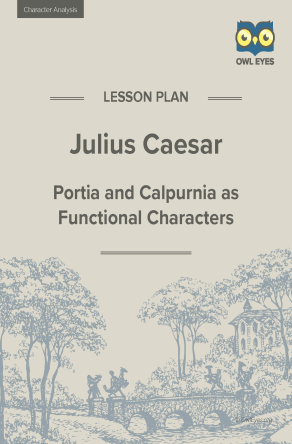Julius Caesar Character Analysis Lesson Plan
- 19 pages
- Subject: Character Analysis, Plot, Themes, Tone, Lesson Plans and Educational Resources
- Common Core Standards: RL.9-10.1, RL.9-10.2, RL.9-10.3, SL.9-10.1
- Grade Levels: 9, 10, 11, 12
Additional Julius Caesar Resources
Product Description
Portia and Calpurnia as Functional Characters in Julius Caesar
This lesson plan focuses on Portia and Calpurnia as minor characters whose primary functions are to enhance the dramatic impact of key scenes and contribute to the development of other characters and themes in the play. Students will identify similarities between Portia and Calpurnia and determine what each woman’s relationship with her husband reveals about him. Students also will determine how Portia’s and Calpurnia’s presence in key scenes advances the plot and creates suspense. By studying Portia and Calpurnia as functional characters, students will be better able to describe how Shakespeare creates suspense as the plot unfolds and further develops Brutus’s and Caesar’s characters as essential elements in the play’s themes.
Skills: close reading, comparing, drawing inferences from the text, collecting evidence through internal research
Learning Objectives: By the end of this lesson, students will be able to
- distinguish between major and minor characters and define functional characters
- describe Portia’s and Calpurnia’s character traits and identify similarities in their characters
- explain how Portia and Calpurnia function in advancing the plot and creating suspense
- describe how Brutus’s and Caesar’s characters are developed through conversations with Portia and Calpurnia
- identify themes in the text that are underscored by Portia’s and Calpurnia’s presence in the play
About This Document
Owl Eyes lesson plans have been developed to meet the demanding needs of today’s educational environment and bridge the gap between online learning and in-class instruction. The main components of each plan include the following:
- An introduction to the text
- A step-by-step guide to lesson procedure
- Previous and following lesson synopses for preparation and extension ideas
- A collection of handouts and worksheets complete with answer keys
Each of these comprehensive, 60-minute plans focus on promoting meaningful interaction, analytical skills, and student-centered activities, drawing from the Common Core Standards for English Language Arts and the expertise of classroom teachers.
Introduction to the Lesson
Based on the assassination of Julius Caesar, which occurred in the Roman Senate on the ides of March (March 15) in 44 BCE, Shakespeare’s play dramatizes the historical event by focusing on several characters who play major roles in the brutal murder and its political aftermath: Brutus, a highly respected Roman senator and Caesar’s friend; Cassius, a manipulative, jealous Roman senator who despises Caesar; Antony, Caesar’s young protégé who is consumed with rage when Caesar is murdered; and Caesar himself, who has assumed dictatorial powers in Rome.
The central conflict that drives the plot is Brutus’s ambivalence regarding the conspiracy to murder Caesar. An honorable man, Brutus struggles with his conscience as he weighs his love for freedom in Rome against his personal friendship with Caesar. Ultimately deciding that his loyalty to Rome and to the freedom of the Roman people must take precedence over his loyalty to Caesar, Brutus joins the conspiracy, participates in stabbing Caesar to death, and suffers the deadly consequences as chaos ensues and Rome is plunged into the civil war instigated by an enraged and now ambitious Antony.
In dramatizing the assassination of Julius Caesar and the subsequent events that ultimately destroy the conspirators, the play, like all good dramas, focuses on character development as the plot unfolds. Of primary importance is the development of Brutus’s and Caesar’s characters prior to the assassination. In establishing the traits in their characters that motivate their actions and lead to Caesar’s murder, Shakespeare employs various methods of characterization, including how Brutus and Caesar interact with minor characters in the play, primarily with Portia and Calpurnia. Although the two wives are not directly involved in the drama’s central conflicts and appear in only a few scenes, their presence in the play serves to reveal traits in their husbands that would otherwise remain unaddressed; it also contributes to creating dramatic suspense prior to Caesar’s impending assassination. Furthermore, Portia’s relationship with Brutus and Calpurnia’s with Caesar add an element of pathos to the drama and underscore its themes.
Julius Caesar is not generally viewed as Shakespeare’s greatest tragedy, a distinction usually reserved for Hamlet or King Lear. However, it remains one of Shakespeare’s most popular plays, and in its examination of personal honor, friendship, civic duty, loyalty, betrayal, political intrigue, and the love of freedom, it is as relevant today as it was when Shakespeare wrote it in 1599 during the reign of Queen Elizabeth I. The drama’s riveting plot, complex characters, memorable poetic language, and universal themes continue to engage audiences, making Julius Caesar a work that endures in the canon of English literature.
Worksheet Excerpt: Analyzing Portia’s Role as a Functional Character
Working as a group, discuss these questions about act II, scene I. Refer frequently to the text as you discuss them. When your group agrees on how the questions should be answered, record your answers on the handout. Choose one person in your group to highlight the title of the scene and write an annotation that sums up what your group has decided about Portia’s role in it. Discuss the annotation as it is being written to make sure it accurately and thoroughly expresses your group’s thinking.
-
Why is Portia worried about Brutus? What does she beg him to do?
-
At what point in the scene does Brutus agree to do it? Why do you think Shakespeare delays Brutus’s agreeing to do what Portia wants him to do?
-
How does Brutus feel about Portia? How does he treat her in this scene?
-
What is revealed about Brutus’s character by how he feels about Portia and how he treats her?
-
Sum it up: How does Shakespeare create suspense and develop Brutus’s character through Portia’s appearing in the scene?







